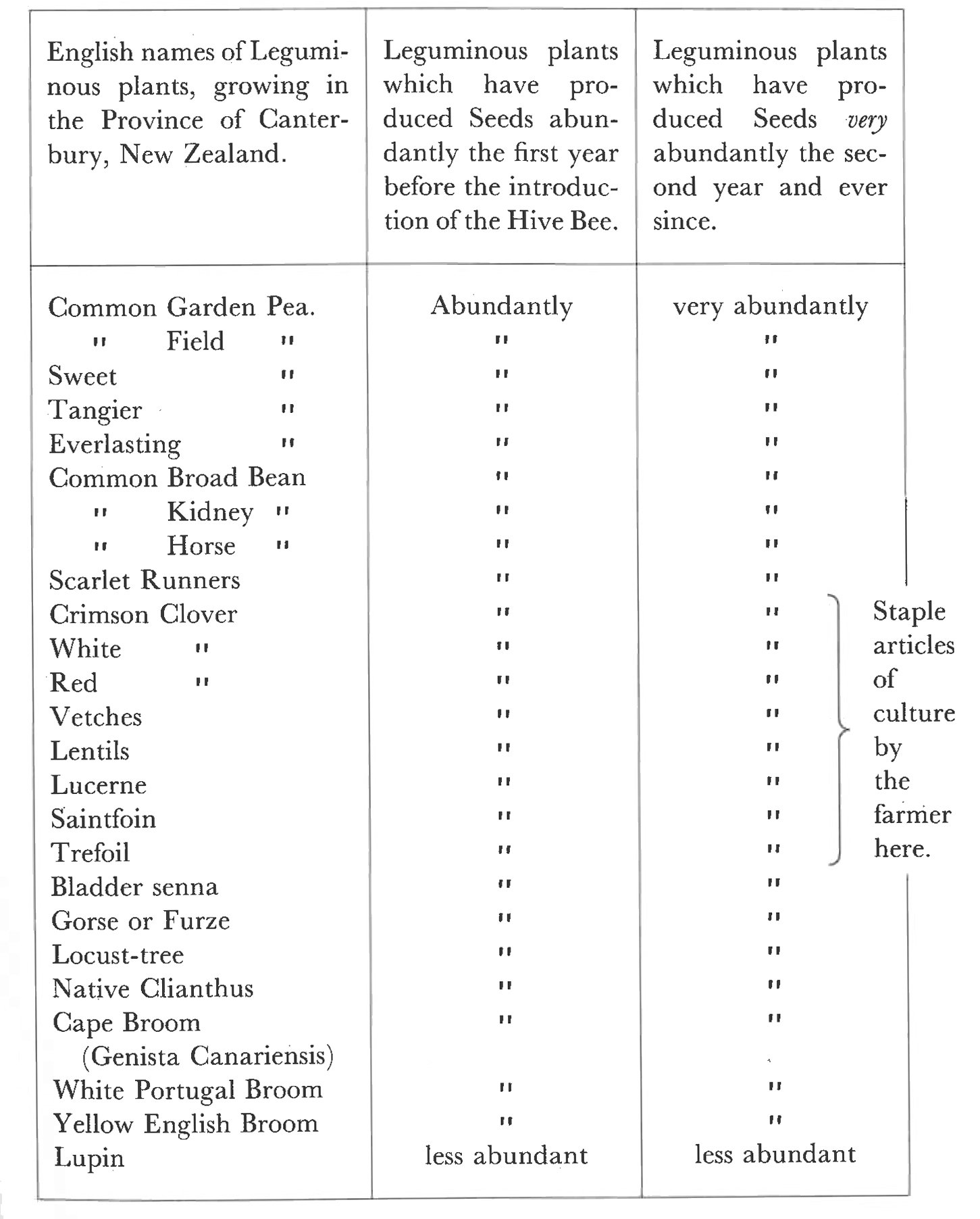From William Swale1 13 July 1858
Christ Church | Province of Canterb⟨ury⟩ | New Zealand
July 13, 1858.
Dear Sir,
Your interesting communication reached me quite safe after a postal journey of 68 days.2 Even in the insect world colonisation has conferred a benifit in this Province. From enquiries which I have made from older Colonists than myself I find that there is not an indigenous Bee. The Bees which are here were introduced from the Province of Wellington in 1852 to this Province; and to Wellington from England in the year 1842. When the first Ships with Emigrants arrived here seven years ago to colonise this Province not a Bee was to be seen, and when the right time arrived for sowing Seeds of the Natural Order Fabaceæ they and other usefull Seeds were sown, and during the Summer those kinds sown such as Peas, Beans, Scarlet Runners, Clovers, and so forth; all prospered and matured their Seeds at the end of the season, and when sown the following season germinated and produced crops again in the usual way: but very abundantly. So abundantly that the red white and crimson clovers are now every where dispersed over this immense Plain wherever the foot-prints of man and Animals can be tracked. The Native Grasses are fast disappearing to make way for the Clovers, Lucerne and English grasses. The enclosed Bees are a sample of the naturalised Bee of this Province.3 There is not the least doubt left in my mind that the function of fertilisation was performed before the introduction of the Hive Bee by the three distinct varieties of native Wasp which I have seen during the summer months. They are smaller than the English wasp: but can sting severely. The two or three varieties of Grasshopper is also very active as well in hopping from flower to flower; and may be added to this, probably the continued high currents of wind which we experience here from time to time which may assist nature to perform her accustomed frolics to facilitate productiveness and the progress of fertilisation by placing the pollen upon the Stigma. The Grasshopper is equally as industrious as the Bee in puncturing the Keel and splitting it open. I have often been amused during the last summer here with his Antics jumping about releasing the Stamens in the Keel. The Garden varieties ⟨of the Lupine seed produced⟩4 less abun-⟨dantly⟩ ⟨than any others⟩ of the Leguminous family. No ⟨ ⟩ and ⟨two words missing⟩ exists with the flower of the Lupin as with the Erythri⟨na⟩ ⟨ ⟩ the tightness of the Keel which before success can be had ⟨must⟩ be artificially opened. I have for amusement during the summer released the Stamens with a pin, and a pod of Seed always rewarded me for my trouble and flowers not served so adjoining have all proved blind.5 The Atmosphere here, by its moderate warmth, its humidity, and constant current, is peculiarly favourable to the Vegetative powers as we daily witness in the luxurious growth of plants, so from the same causes it suits the Hive Bee. Children grow well and strong, with fresh and rosy faces and I am satisfied that in this respect this Province is superior to Great Britain. The Bees here are able to feed themselves all the year round.

The Common Furze is always in bloom and universally used for fences. My present employer has sold more than 100,000 one-year old Seedling Gorse plants this winter. In a warm sheltered situation in his Nursery-grounds one old Hive cast off six swarms during the short time of two months.
English Bee Keepers would open their eyes with astonishment if they were out here to see the produce of a single hive. I have had the pleasure several times of partaking of their industry and most delicious it is. Bee Keeping is different here to what it is in England. The perpetual succession of flowers, and the fine warm Summer, mildness of the winter, all tends to a great increase of the ⟨bees. Our management of them is⟩ very ⟨simple. We furnish them with small boxes 18 inches⟩ or 2 feet in length and a foot ⟨or 18 inches in⟩ depth with a small aperture on the Sunny side fo⟨r in⟩gress and egress. Inside the box we fix small rails ⟨a⟩cross for them to commence building their combs. I have seen very severe conflicts between them and the native Wasps. When a wasp approaches near the Hive the Bees give no quarters. They soon slay their enemy and down with him.
Dear Sir, you are perfectly welcome to the contents of my Letter and quite at liberty to make use of the same.
Very faithfully yours | Wm Swale
CD annotations
CD note:6
Footnotes
Summary
Discusses the absence of a native bee in New Zealand and the insects which probably performed its fertilising function [see "Agency of bees in fertilization", Collected papers 2: 21]. Describes the success of the naturalised hive-bee and also the rapid spread of introduced members of the Fabaceae.
Letter details
- Letter no.
- DCP-LETT-2308
- From
- William Swale
- To
- Charles Robert Darwin
- Sent from
- Christchurch
- Source of text
- DAR 177: 323 (fragile), DAR 205.4: 79
- Physical description
- ALS 3pp damaged †, CD note
Please cite as
Darwin Correspondence Project, “Letter no. 2308,” accessed on 19 April 2024, https://www.darwinproject.ac.uk/letter/?docId=letters/DCP-LETT-2308.xml
Also published in The Correspondence of Charles Darwin, vol. 7


